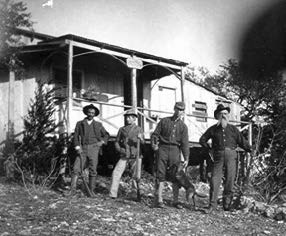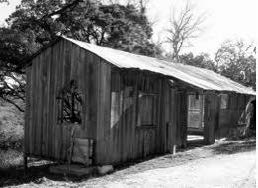Beckmann Ranch and the Merry Knights of King William
Our consulting firm, Abasolo Archaeological Consultants, conducted an archaeological survey of the Madla Natural Area property in Grey Forest in 2011 and recorded a small board and batten historic structure that dates to the 19th century. Researching this structure and property led us back to King William.

The first settlement of the area, part of which is today the Madla Natural Area property near Helotes, was by John Conrad Beckmann (1815-1907). A German immigrant, Beckmann was a blacksmith and wrought-iron craftsman at the time that he and his wife (Regina Mueller) moved
to San Antonio, with their first child, Heinrich. Their youngest child, Albert, became a well known architect and built the house at 222 E. Guenther St. The Beckmann Ranch was formed in 1852, when it was purchased from early San Antonio developers Thomas Devine and F. Giraud.
There is considerable information (and a fair amount of myth) surrounding the ranch, Indian raids, land transfers, deeds, buildings and the like. Presently, the Daughters of the Republic of Texas Library have archived the John Conrad Beckmann Papers, with further materials being added at the time of this report by David and Myrna Langford. Deeds dealing with lands associated with the Beckmann Ranch can be found at the Office of the County Clerk, along with many deeds involving John Conrad Beckmann’s property acquisitions within San Antonio.
The Beckmann Ranch consisted of 320 acres of hills, canyons and farmlands, cut by Helotes Creek. At the time, the locality was known as “Canon de los Helotes” and had few settlers. It is reported that Beckmann promised his wife, Regina, that he would build her a “Swiss chalet” in light of homesickness for her native Switzerland. The reference to a “Swiss chalet” must have been a joke, because the first house built on the property was a house of sticks (Susan Beavin, personal communication, 2011). Presumably it was this house that was built in 1852-1853 and was later replaced by the board and batten structure. The Beckmanns lived in San Antonio and only occasionally visited their “country” property. They hired a “Mexican family” to be caretakers at the ranch. All members of that family were killed by “Indians” in 1853, at a time that the family was reportedly living in the “Swiss chalet” (Massey 2008: 43). This was one of several such raids in the area in that year.
The ranch was used by a variety of individuals for a variety of reasons up through the 1920s. One deed of note in the Office of the Bexar County Clerk, dated August 3, 1905, apparently involves the sale, for $1.00, of 344 acres in the “Canon de Helotes.” John A. Beckmann (second son) apparently sold this property back to his father, John C. Beckmann, with this deed. Obviously, a great deal of deed research would have to be done to follow all of the land sales involved the Beckmann Ranch; John C. Beckmann was about 90 years old at this time.

Beckmann Hill was a popular destination for hunting parties, and the ranch was used as a hunting retreat by the Beckmanns and their friends and relatives in the late 19th and well into the 20th century. Remnants of the board and batten hunting lodge or cabin used by the Beckmanns and the Beckmann boys’ friends remains as shown by the graffiti still on the walls. It was also a popular hunting retreat for the members of the Merry Knights of King William.
The historic connection of the Beckmann historic cabin at the Madla Natural Area property to King William is related in the history of this interesting
men’s club compiled by Walter Berman and Kurt Beckmann, both former members of the club. The Merry Knights of King William was a secret society organized in 1909 by several King William neighborhood teenagers, Willard Berman, Arthur L. Bergstrom and Walter G. Giesecke (Bergstrom 1976). Joining them at that time were Percy W. Clarkson, Frederick W. Bolinger, Werner N. Beckmann, Albert Beckmann, Henry Pancoast, Harry Ankerson, George Henyan and Ernst F. Schuchard. By 1916 there were 29 members and by 1975 the list included 109 names of members and former members, many of them deceased by that time.
This organization’s meeting place was a refurbished room in the carriage house behind 208 King William Street. The boys did all of the necessary work to convert the carriage house to a meeting room. World War I interrupted their activities. Following the war the organization became a men’s club whose sole purpose was “to have fun” (Beckmann 1976). The club, originally named the Mystic Knights of King William, became very prominent and popular in the neighborhood. They held an annual wild game dinner, often at Beckmann Hill near Grey Forest, the only time females were allowed to attend meetings. Schuchard made red and grey shields and wooden swords for each knight. They wore robes similar to those of the Klu Klux Klan and held candlelight ceremonies and initiations (Bergstrom 1976). Secret societies and clubs were commonplace among boys and teens in the first part of the 20th century. There is no record of the club activity being racist and membership simply was composed of boys and young men in the King William neighborhood that was made up mostly of descendants of German immigrants (Kurt Beckmann 1976). Beckmann (1976) also noted that they had their own handshake, secret recognition whistle and motto (“Every Progressive, Honest, and Friendly”). Their colors were scarlet and silver; the flower was red carnation. The activities of the members as boys were swimming and canoeing in the San Antonio River, swimming in the Oma Steves’ natatorium (where the Conservation Society River House is today), top spinning, marble shooting, tennis, football and baseball. As men, they went camping, hiking, swimming and hunting, including at the Beckmann Ranch. The connection to the board and batten structure to the Merry Knights was their annual Founder’s Day weekend and wild game dinner which was first held on Beckmann Hill (Bergstrom 1976).
The Merry Knights socialThe Merry Knights social group still exists and consists of male descendants of the former members, according to Judge Fred Shannon, a former member himself who had joined the club in 1975. Judge Shannon recalled that there were monthly meetings but no dues. The only “dues” was that three members would host a monthly dinner with drinks and card games, and this responsibility would be rotated; an annual banquet was also held and this was the only time that wives or women guests were invited to attend.
– Harry J. Shafer and Thomas R. Hester